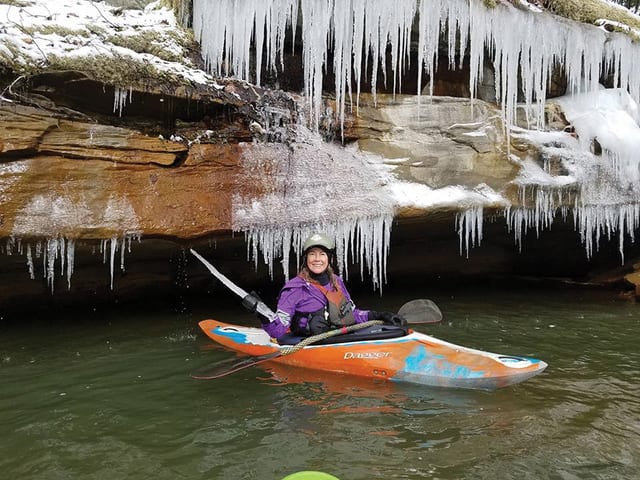When life gets stressful, meditation, fresh air, and exercise can often help relieve the tension. Sue Melbourne prefers to do all three at the same time, through kayaking.
“It’s about connecting to the river and being in the flow. Specifically with whitewater kayaking, you have to concentrate on the waves and rapids; it requires all of your attention,” Melbourne says. “For me, that’s the perfect form of meditation. I’m not thinking of anything else.”
Even when there’s snow on the ground and many people try to spend as little time as possible outside, Melbourne and her friends kayak.
“No temperature yet has prevented me from going outside,” she says. “The wind chill is a different story. I’d rather kayak on a 10-degree sunny day with no wind, then a 30-degree windy, cloudy day. On the windy, cold days my friends and I sometimes have to encourage each other to meet up and paddle or ski. It’s easier to keep an outdoor plan when there is a friend relying on you.”
Although she’s traveled pretty far to kayak, for shorter day trips Melbourne heads out to Black Moshannon River or Spring Creek. Centre County is home to her whitewater paddling club, where she’s made some of her closest friends. The group is on Facebook and encourages first-time kayakers to come out and join them, and they always learn from each other. While they encourage people of varying skillsets to come out in the summer, Melbourne says only experienced kayakers should go in the winter.
“You have to be a solid, confident kayaker to paddle in the winter because you want to stay upright,” she says. “Whitewater kayaks tend to be unstable and if you’re not paying attention, you’ll flip, and be upside down in freezing cold water. You put the whole group you’re with at risk if they need to rescue you.”
Even an experienced whitewater kayaker might flip once in a while. But because they have the experience, they’re less likely to be in danger.
“I’ve had to swim while there was snow twice now,” says State College resident Matt Umbel. “I was running a more difficult drop and the boat flipped – it felt like an ice cream headache times 1,000, or a full-body ice bucket challenge. The shock of the cold hits you, then the adrenaline kicks in and you go into survival mode, you need to make sure you rescue yourself, and then worry about your boat and gear.”
Umbel says that both times he flipped, his friends helped him get his gear and kayak. He didn’t have to swim too far to get to safety. With the right clothing, about half an hour after, he was dry and warm.
“You never want to go alone, and you want to make sure you’re ready for anything,” he says.
Melbourne adds that you should dress for the worst-case scenario. With kayaking, that means being prepared to swim.
I have a dry bag filled with extra layers, headlamp, fire starter, and various ropes and equipment to aid in a rescue,” she says. “Under my dry suit, I dress in layers of wool or synthetic fabrics. Next to the skin I wear a wicking layer to draw perspiration to the outer absorbent layers. Never wear cotton outdoors in the winter. Lastly, I wear gloves, a hat, and footwear appropriate for the activity and weather. In kayaking, we have much more to consider because the water will freeze the zippers on our life jackets and dry suits, so we need to plan ahead to ensure that we can access our car keys and safety gear when needed. The extra winter preparations take time, but once my friends and I are outdoors smiling ear to ear, we know it was all worth it.”
Aaron Fleishman started kayaking six years ago and hasn’t stopped. Along with friends like Umbel and Melbourne, Fleishman kayaks through all four seasons and has started teaching the sport as well.
“I just enjoy being outside, no matter what time of year,” he says. “Kayaking lets me access waterways that would otherwise be difficult. It seems like every time I go out, I try something new, I see something new, and it’s always great.”
The appeal of kayaking in the winter, he says, is that there are fewer people on the water, which leads to more peaceful surroundings and different challenges that are more fun.
Many kayaking enthusiasts have bigger cars so that they can not only haul their kayak to and from water, but sleep in the car when they are kayaking in more remote locales. Melbourne, Umbel, and Fleishman have all occasionally camped in their cars, and in tents, in the winter before or after kayaking.
“They make winter tents that are designed to keep the heat in,” says Melbourne. “It’s magical to tent in the snow with friends – few people are around so you’re really in nature and because it’s quiet, you see a lot more animals in the winter. I’ve seen bears, deer, fox, bald eagles, and owls.”
Rebekka Coakley is a freelance writer.



